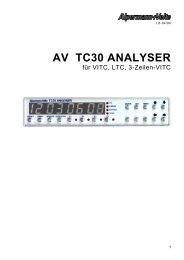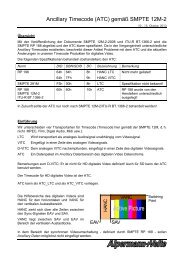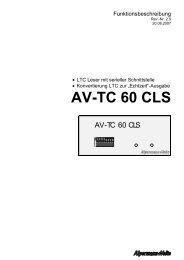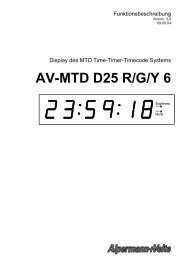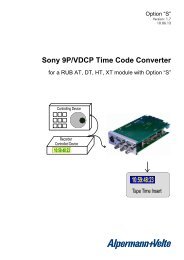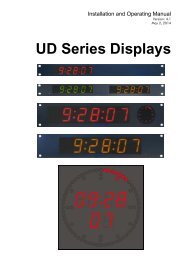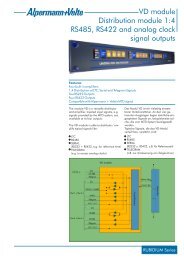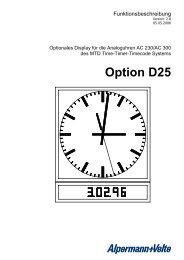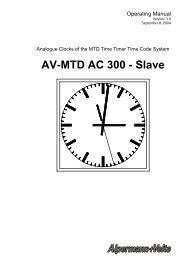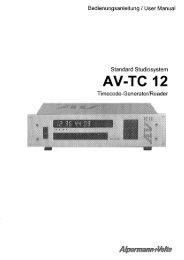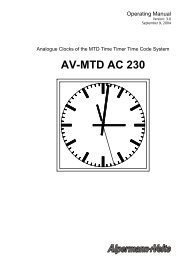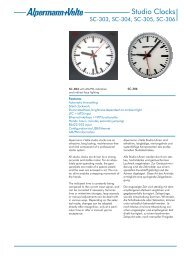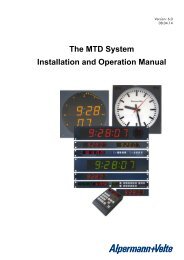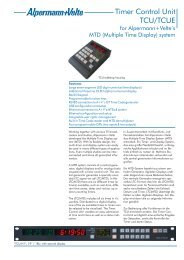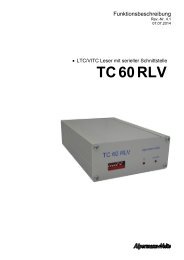GM-TTT - Alpermann+Velte
GM-TTT - Alpermann+Velte
GM-TTT - Alpermann+Velte
- No tags were found...
You also want an ePaper? Increase the reach of your titles
YUMPU automatically turns print PDFs into web optimized ePapers that Google loves.
Installation & Operation Manual <strong>GM</strong>-<strong>TTT</strong>Page 101 Introduction to the <strong>GM</strong>-<strong>TTT</strong>1.1 OverviewThe <strong>GM</strong>-<strong>TTT</strong>generates linear time code (LTC) and can also optionally generate a verticalinterval time code (VITC). The frames/second can be selected from most widely used formatsincluding 24, 25, 30 and 30 drop frame. The unit generates time code according to theSMPTE standard ANSI/SMPTE 12M-1995 (revision of ANSI/SMPTE 12M-1986) for thetelevision systems 625/50 (PAL) and 525/60 (NTSC).Time and binary groups information are displayed on the 8-digits front display panel. Timeand binary groups can be pre-set by using buttons on the front panel, by an external LTC orby an external reference signal (for e.g. receiving time and date from a DCF77 or GPSreceiver). With the <strong>Alpermann+Velte</strong> MTD system the time may also be set from one of the sixinternal timers A - F (described below).The LTC signal can be phase-locked to it’s own internal reference (x’tal, temperature compensated)or to an external genlocking signal (video or black-burst television signal, external LTCsource, real time seconds pulse).<strong>GM</strong>-<strong>TTT</strong>was designed for video studios and broadcast stations. External synchronising signalspass through special filters, so that noise or other disturbances in these signals do not affectthe time code output. This ensures that the time code is permanently available, continuouslyup-counting, and without any faults even if there is a drop-out of the external synchronisingsignal. Further effort has been made to professionally handle the real time coupling. The unitsupplies all information required to adjust the time code and the SPG (sync pulse generator) toa real time reference signal. Real time references presently include GPS or DCF77 receivers.<strong>GM</strong>-<strong>TTT</strong>is a master time code generator and the central unit of the <strong>Alpermann+Velte</strong> MTDsystem at the same time. <strong>Alpermann+Velte</strong> has uniquely developed a system we call theMultiple Time Display System (MTD). This system supplies the video studio with timeinformation as local time, date, time code, VTR time code, up/down counting timers etc. AMTD system consists of a central generator, digital displays and/or index clocks and at leastone control unit. The central generator generates a specific LTC format which will be referredto as LTC(MTD) in this document. The LTC(MTD) transfers data to all digital displays andincludes all the time information that were mentioned above. The control units communicatewith the central generator via a RS485 bus and are connected to the LTC (MTD)/RS485connector.The front panel of a <strong>GM</strong>-<strong>TTT</strong>has buttons and a display, these are necessary to configure andoperate the unit. All important functions may be switched easily and quickly by using thesebuttons. A KEYLOCK function is available to avoid unintentional key presses (used after anapplication has been properly set-up and changes are no longer needed).



